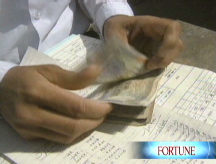Lending market in slight expansion
Fed program increases businesses' borrowing in commercial paper market, but experts say private investors are still not lending.
NEW YORK (CNNMoney.com) -- A key market for business lending has expanded for the fourth straight week, but the growth was only incremental, according to Federal Reserve data released Thursday.
The amount of so-called commercial paper that was sold in the seven days ended Nov. 19 rose by $11.1 billion, or 0.7%, to a seasonally adjusted $1.61 trillion, the report said.
Commercial paper is short-term debt that big businesses and financial institutions sell primarily to money-market fund managers and other institutional investors. The companies use the loans to fund day-to-day business operations. The market for it, particularly for three-month paper, dried up after the collapse of Lehman Brothers in mid-September.
On Oct. 20, the Fed began to buy up hundreds of billions of dollars of high-quality, three-month commercial paper through its Commercial Paper Funding Facility. The program immediately boosted the market, but has grown incrementally in the past few weeks, signaling that market investors have not joined in the Fed's efforts to buy up corporate debt.
"The commercial paper market is now heavily dependent on credit facilities created by the Federal Reserve," said FDIC chairwoman Sheila Bair in testimony before the House Financial Services committee Tuesday. "In this environment, banks will need to provide a greater share of credit intermediation than in the past to support normal levels of economic activity."
Last week, a separate Fed report showed that the government bought nearly $14 billion of commercial paper, but total commercial paper on the market rose by just a fraction of that - $2.9 billion. The Fed will announce how much commercial paper it bought in the past week at 4:30 p.m. ET Thursday.
Commercial paper had once been considered a safe and liquid investment, bought chiefly by conservative investors like money-market funds. But when the credit crisis hit two months ago, money markets began to suffer losses, and droves of investors pulled their money out. To save a sinking ship, money-market fund managers began to invest in even safer assets like U.S. Treasurys, refusing to buy commercial paper unless it matured overnight or in a matter of days.
The commercial paper market plummeted by more than a fifth in just six weeks, and businesses had a difficult time acquiring necessary short-term financing. Interest rates soared, so the funding businesses could acquire was expensive and needed to be rolled over on a daily basis.
As a result, the Fed developed three programs to address the problems. First, the Fed moved in to save the crumbling money-market funds by backstopping banks' purchases of asset-backed commercial paper from the funds.
The Fed then opened the Commercial Paper Funding Facility, purchasing more than $250 billion of paper that matures in three-months. The facility has allowed many firms to extend funding into 2009, according to Fed chief Ben Bernanke in testimony before the House Financial Services committee.
Several dozen companies registered for the Fed's program, including General Electric Co. (GE, Fortune 500), which is the largest issuer of commercial paper. Other companies subscribing to the program include Morgan Stanley (MS, Fortune 500), car and home lender GMAC (GMA), American Express (AXP, Fortune 500), and bailed-out insurance firm AIG (AIG, Fortune 500).
Next week, the Fed is expected to open a third facility that will backstop the money-market funds themselves, in an attempt to encourage funds to buy long-term paper again and reduce companies' reliance on the Commercial Paper Funding Facility.
Bernanke said that the programs are slowly helping to restore liquidity to the credit market.
"There are some signs that credit markets, while still quite strained, are improving," said Bernanke on Tuesday. "We are seeing greater stability in money market mutual funds and in the commercial paper market."
"However, overall, credit conditions are still far from normal," he cautioned. ![]()



